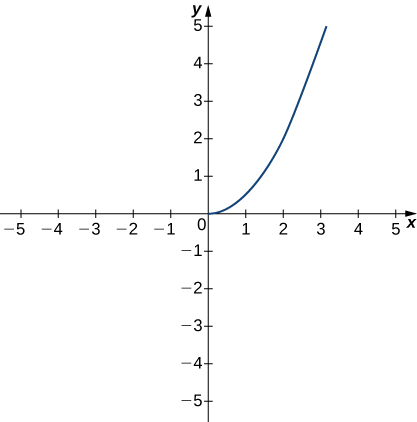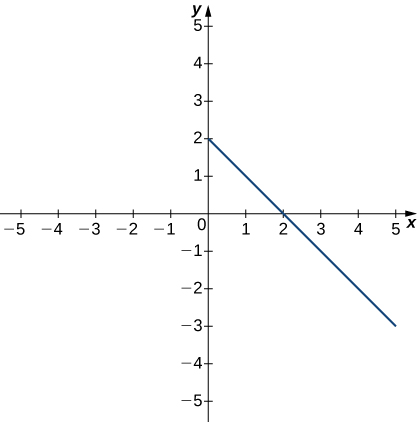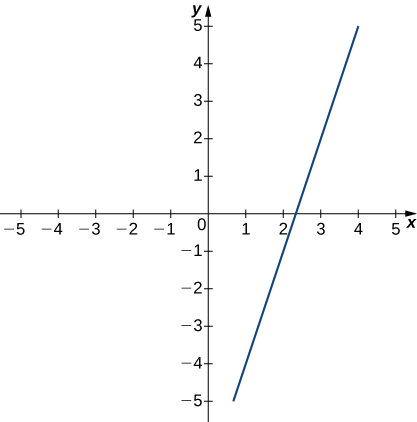2.8E: Exercises for Section 2.7
- Last updated
- Mar 16, 2023
- Save as PDF
- Page ID
- 123881
( \newcommand{\kernel}{\mathrm{null}\,}\)
In exercises 1 - 4, write the appropriate ε−δ definition for each of the given statements.
1) lim
2) \displaystyle \lim_{t →b}g(t)=M
- Answer
- For every ε >0, there exists a δ >0, so that if 0 <|t −b| < δ, then |g(t) −M| < ε
3) \displaystyle \lim_{x →c}h(x)=L
4) \displaystyle \lim_{x →a} φ(x)=A
- Answer
- For every ε >0, there exists a δ >0, so that if 0 <|x −a| < δ, then | φ(x) −A| < ε
The following graph of the function f satisfies \displaystyle \lim_{x →2}f(x)=2. In the following exercises, determine a value of δ >0 that satisfies each statement.

5) If 0 <|x −2| < δ, then |f(x) −2| <1.
6) If 0 <|x −2| < δ, then |f(x) −2| <0.5.
- Answer
- δ ≤0.25
The following graph of the function f satisfies \displaystyle \lim_{x →3}f(x)= −1. In the following exercises, determine a value of δ >0 that satisfies each statement.

7) If 0 <|x −3| < δ, then |f(x)+1| <1.
8) If 0 <|x −3| < δ, then |f(x)+1| <2.
- Answer
- δ ≤2
The following graph of the function f satisfies \displaystyle \lim_{x →3}f(x)=2. In the following exercises, for each value of ε, find a value of δ >0 such that the precise definition of limit holds true.

9) ε=1.5
10) ε=3
- Answer
- δ ≤1
[T] In exercises 11 - 12, use a graphing calculator to find a number δ such that the statements hold true.
11) \left|\sin(2x) −\frac{1}{2}\right| <0.1, whenever \left|x −\frac{ π}{12}\right| < δ
12) \left|\sqrt{x −4} −2\right| <0.1, whenever |x −8| < δ
- Answer
- δ <0.3900
In exercises 13 - 17, use the precise definition of limit to prove the given limits.
13) \displaystyle \lim_{x →2}\,(5x+8)=18
14) \displaystyle \lim_{x →3}\frac{x^2 −9}{x −3}=6
- Answer
- Let δ= ε. If 0 <|x −3| < ε, then \left|\dfrac{x^2 −9}{x −3} - 6\right| = \left|\dfrac{(x+3)(x −3)}{x −3} - 6\right| = |x+3 −6|=|x −3| < ε.
15) \displaystyle \lim_{x →2}\frac{2x^2 −3x −2}{x −2}=5
16) \displaystyle \lim_{x →0}x^4=0
- Answer
- Let δ=\sqrt[4]{ ε}. If 0 <|x| <\sqrt[4]{ ε}, then \left|x^4-0\right|=x^4 < ε.
17) \displaystyle \lim_{x →2}\,(x^2+2x)=8
In exercises 18 - 20, use the precise definition of limit to prove the given one-sided limits.
18) \displaystyle \lim_{x →5^ −}\sqrt{5 −x}=0
- Answer
- Let δ= ε^2. If - ε^2 < x - 5 < 0, we can multiply through by -1 to get 0 <5-x < ε^2.
Then \left|\sqrt{5 −x} - 0\right|=\sqrt{5 −x} < \sqrt{ ε^2} = ε.
19) \displaystyle \lim_{x →0^+}f(x)= −2, where f(x)=\begin{cases}8x −3, & \text{if }x <0\\4x −2, & \text{if }x ≥0\end{cases}.
20) \displaystyle \lim_{x →1^ −}f(x)=3, where f(x)=\begin{cases}5x −2, & \text{if }x <1\\7x −1, & \text{if }x ≥1\end{cases}.
- Answer
- Let δ= ε/5. If − ε/5 < x - 1 <0, we can multiply through by -1 to get 0 <1-x < ε/5.
Then |f(x) −3|=|5x-2-3| = |5x −5| = 5(1-x), since x <1 here.
And 5(1-x) < 5( ε/5) = ε.
In exercises 21 - 23, use the precise definition of limit to prove the given infinite limits.
21) \displaystyle \lim_{x →0}\frac{1}{x^2}= ∞
22) \displaystyle \lim_{x → −1}\frac{3}{(x+1)^2}= ∞
- Answer
- Let δ=\sqrt{\frac{3}{N}}. If 0 <|x+1| <\sqrt{\frac{3}{N}}, then f(x)=\frac{3}{(x+1)^2} >N.
23) \displaystyle \lim_{x →2} −\frac{1}{(x −2)^2}= − ∞
24) An engineer is using a machine to cut a flat square of Aerogel of area 144 \,\text{cm}^2. If there is a maximum error tolerance in the area of 8 \,\text{cm}^2, how accurately must the engineer cut on the side, assuming all sides have the same length? How do these numbers relate to δ, ε, a, and L?
- Answer
- 0.033 \text{ cm}, \, ε=8,\, δ=0.33,\,a=12,\,L=144
25) Use the precise definition of limit to prove that the following limit does not exist: \displaystyle \lim_{x →1}\frac{|x −1|}{x −1}.
26) Using precise definitions of limits, prove that \displaystyle \lim_{x →0}f(x) does not exist, given that f(x) is the ceiling function. (Hint: Try any δ <1.)
- Answer
- Answers may very.
27) Using precise definitions of limits, prove that \displaystyle \lim_{x →0}f(x) does not exist: f(x)=\begin{cases}1, & \text{if }x\text{ is rational}\\0, & \text{if }x\text{ is irrational}\end{cases}. (Hint: Think about how you can always choose a rational number \(0
28) Using precise definitions of limits, determine \displaystyle \lim_{x →0}f(x) for f(x)=\begin{cases}x, & \text{if }x\text{ is rational}\\0, & \text{if }x\text{ is irrational}\end{cases}. (Hint: Break into two cases, x rational and x irrational.)
- Answer
- 0
29) Using the function from the previous exercise, use the precise definition of limits to show that \displaystyle \lim_{x →a}f(x) does not exist for a ≠0
For exercises 30 - 32, suppose that \displaystyle \lim_{x →a}f(x)=L and \displaystyle \lim_{x →a}g(x)=M both exist. Use the precise definition of limits to prove the following limit laws:
30) \displaystyle \lim_{x →a}(f(x) −g(x))=L −M
- Answer
- f(x) −g(x)=f(x)+( −1)g(x)
31) \displaystyle \lim_{x →a}[cf(x)]=cL for any real constant c (Hint: Consider two cases: c=0 and c ≠0.)
32) \displaystyle \lim_{x →a}[f(x)g(x)]=LM. (Hint: |f(x)g(x) −LM|= |f(x)g(x) −f(x)M +f(x)M −LM| ≤|f(x)||g(x) −M| +|M||f(x) −L|.)
- Answer
- Answers may vary.

